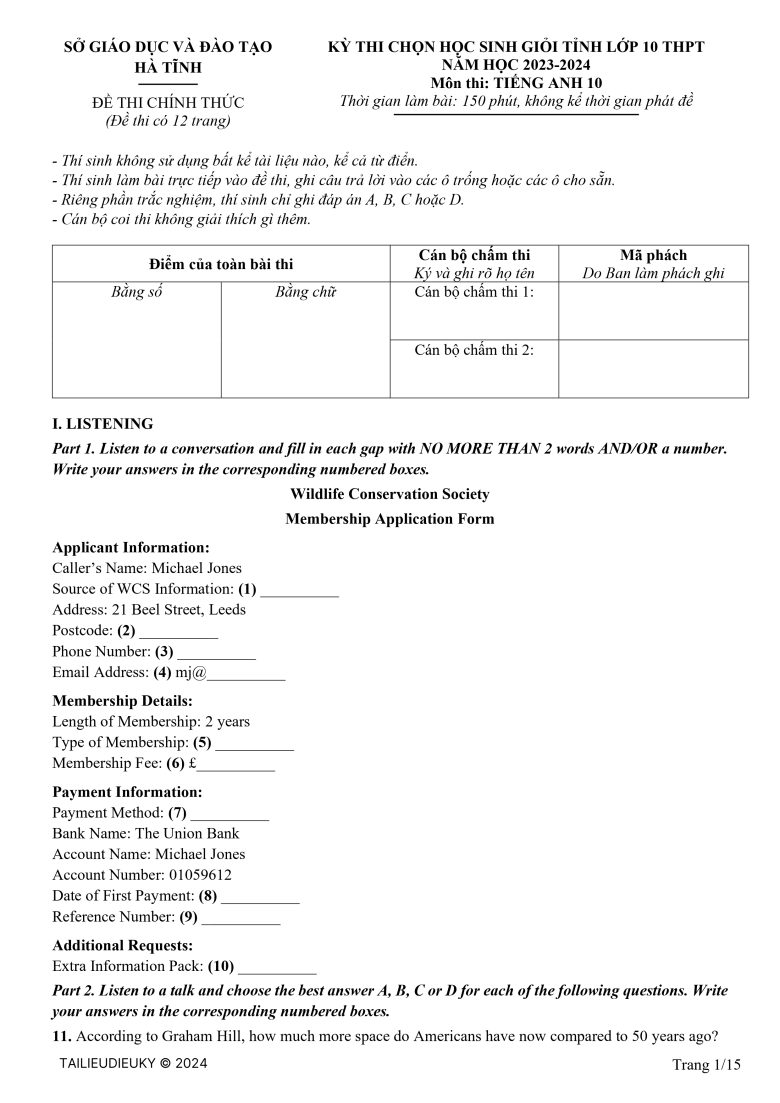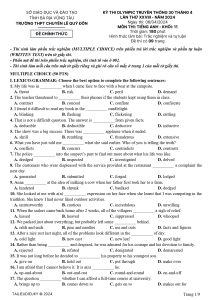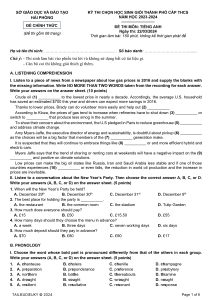Tài liệu diệu kỳ giới thiệu Đề thi HSG Tiếng Anh 10 cấp tỉnh Hà Tĩnh năm học 2023-2024 có đáp án và file nghe đầy đủ có thể tải xuống dạng file word và pdf thi ngày 04/03/2024 do sở GD&ĐT Hà Tĩnh tổ chức. Tổng quan, đề thi chính thức có 12 trang gồm 115 câu hỏi (trắc nghiệm và tự luận) và 01 bài essay, thời gian làm bài là 150 phút. Quý thầy cô và các em học sinh có thể tải file ở đường dẫn phía dưới để bồi dưỡng và luyện tập chuẩn bị cho Kỳ thi HSG tỉnh năm học 2024-2025.
Theo Sở Giáo dục và Đào tạo tỉnh, Kỳ thi Học sinh giỏi tỉnh lớp 10 THPT tại Hà Tĩnh đã diễn ra vào ngày 4/3/2024 với sự tham gia của 1.299 thí sinh. Thí sinh tham gia thi ở 10 bộ môn khác nhau bao gồm: Toán, Ngữ văn, Tiếng Anh, Tiếng Pháp, Vật lý, Hóa học, Sinh học, Tin học, Lịch sử, và Địa lý. Trong số đó, tổng cộng có 879 thí sinh đạt giải.
Để tra cứu kết quả thi, các thí sinh có thể truy cập vào trang web của Sở Giáo dục và Đào tạo Hà Tĩnh tại địa chỉ sau: http://hatinh.edu.vn/tracuudiemthihsg
Đề thi chính thức môn Tiếng Anh 10 trong Kỳ thi học sinh giỏi cấp tỉnh gồm 4 phần chính, tổng điểm toàn bài thi được tính trên thang điểm 20. Qua đó đánh giá khả năng sử dụng Tiếng Anh của thí sinh trên 3 Kỹ năng: Nghe, Đọc và Viết.
I. Listening (25 câu x 0.2 = 5 điểm)
Gap Filling, Multiple choice questions, True/False
II. Lexico-Grammar (40 câu x 0.125 = 5 điểm)
Vocabulary and grammar exercises, including multiple-choice questions, word error correction, and matching phrases to form collocations.
III. Reading (40 câu x 0.125 = 5 điểm)
The section includes reading and vocabulary selection exercises, with passages discussing technological advancements and their impact on human communication. It also delves into the complexity of the relationship between technology and feelings of isolation.
IV. Writing (10 câu x 0.2 = 2 điểm và Essay writing: 3 điểm)
Sentence transformation exercises, followed by an essay topic on school workouts' benefits for students' health.
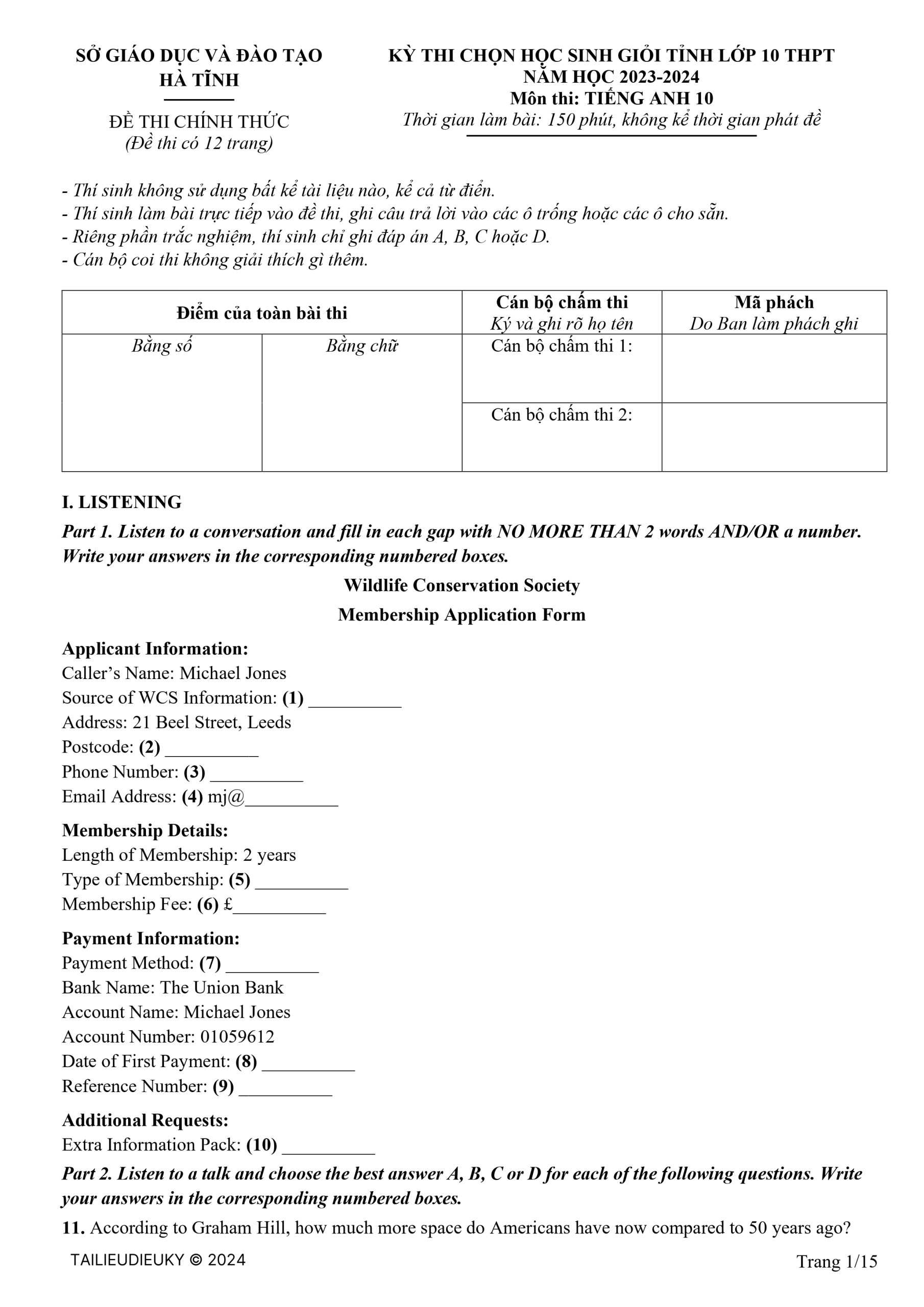
Đề thi HSG Tiếng Anh 10 cấp tỉnh Hà Tĩnh năm học 2023-2024 - Trang 1/12
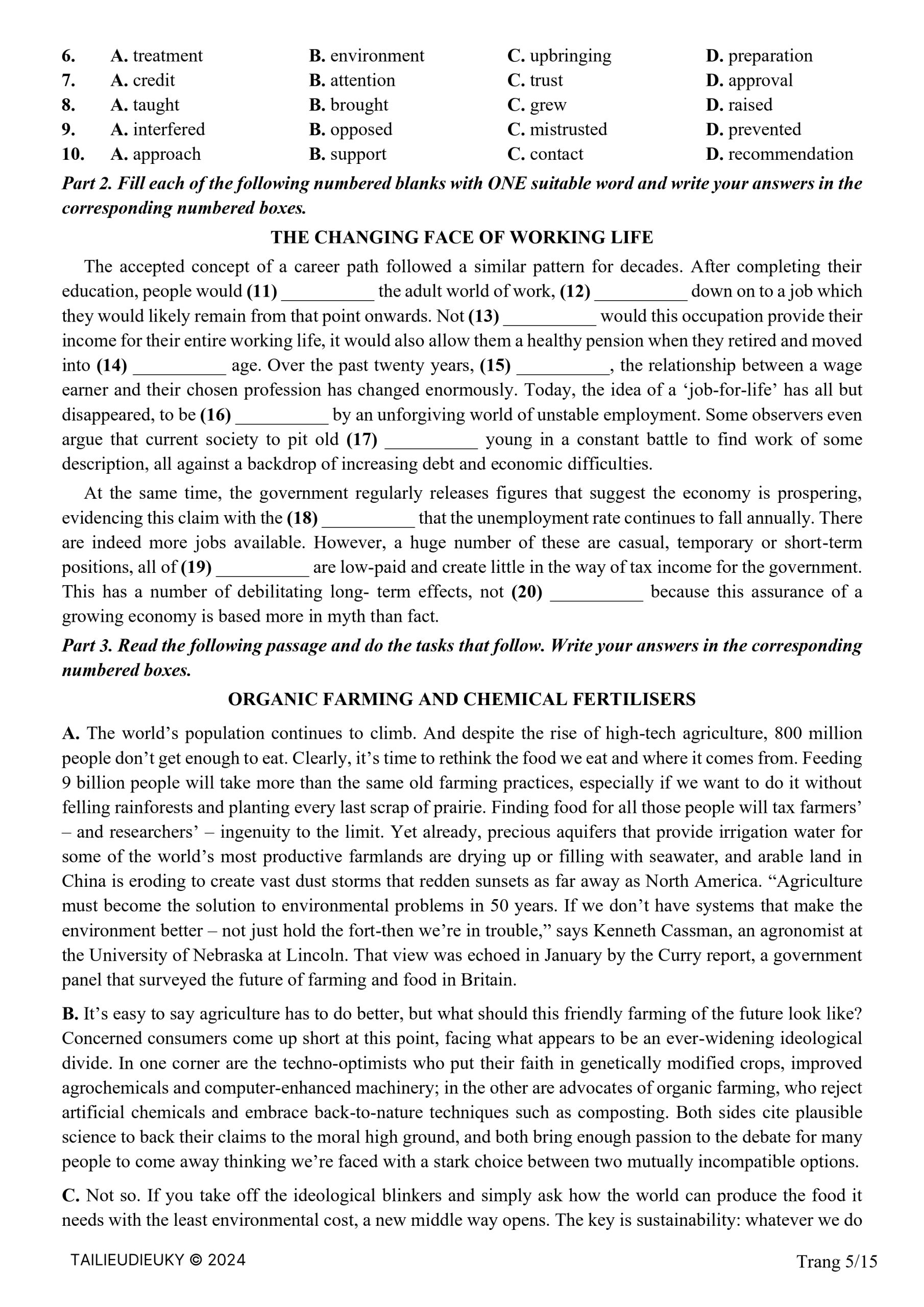
Đề thi HSG Tiếng Anh 10 cấp tỉnh Hà Tĩnh năm học 2023-2024 - Trang 5/12
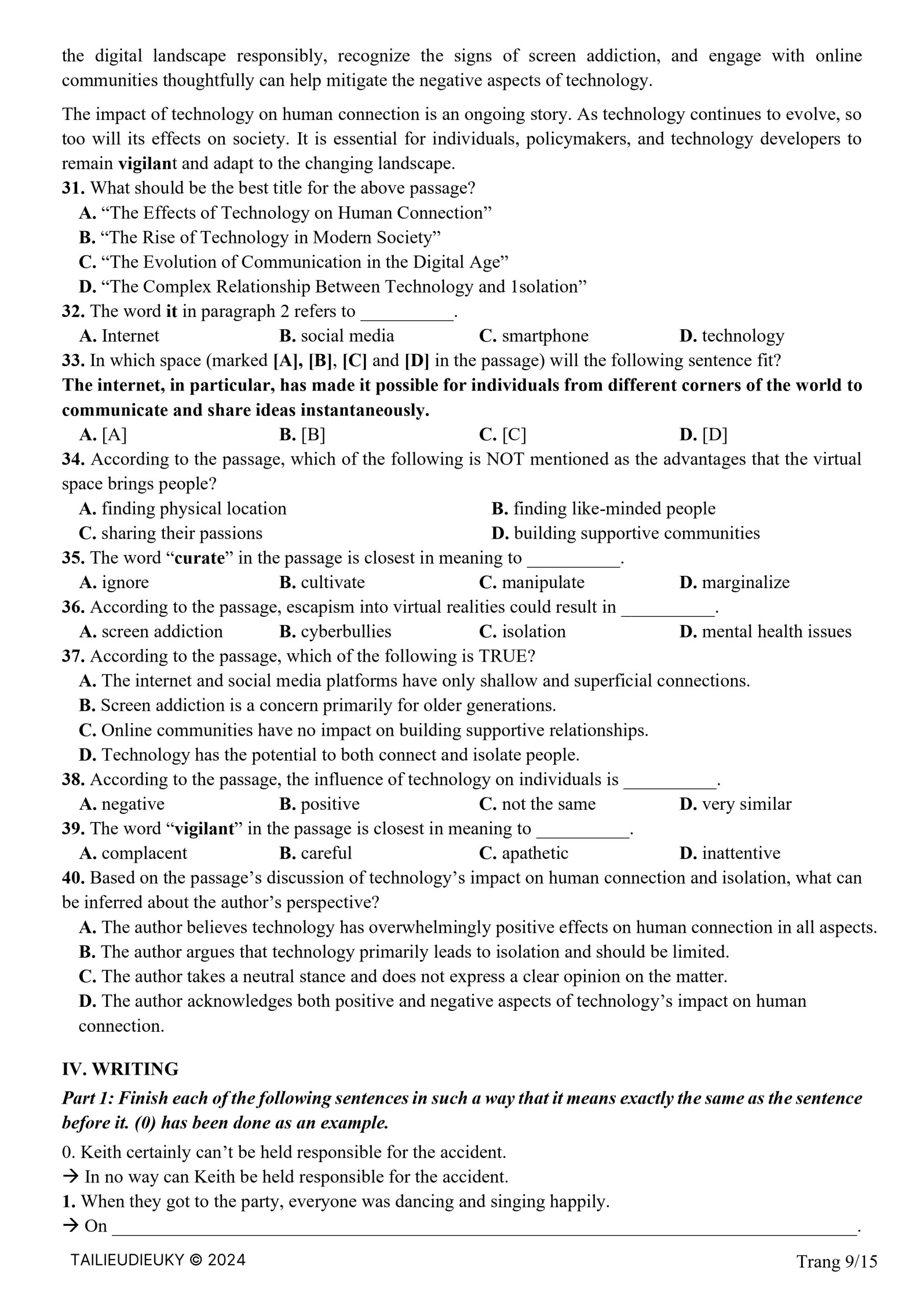
Đề thi HSG Tiếng Anh 10 cấp tỉnh Hà Tĩnh năm học 2023-2024 - Trang 9/12
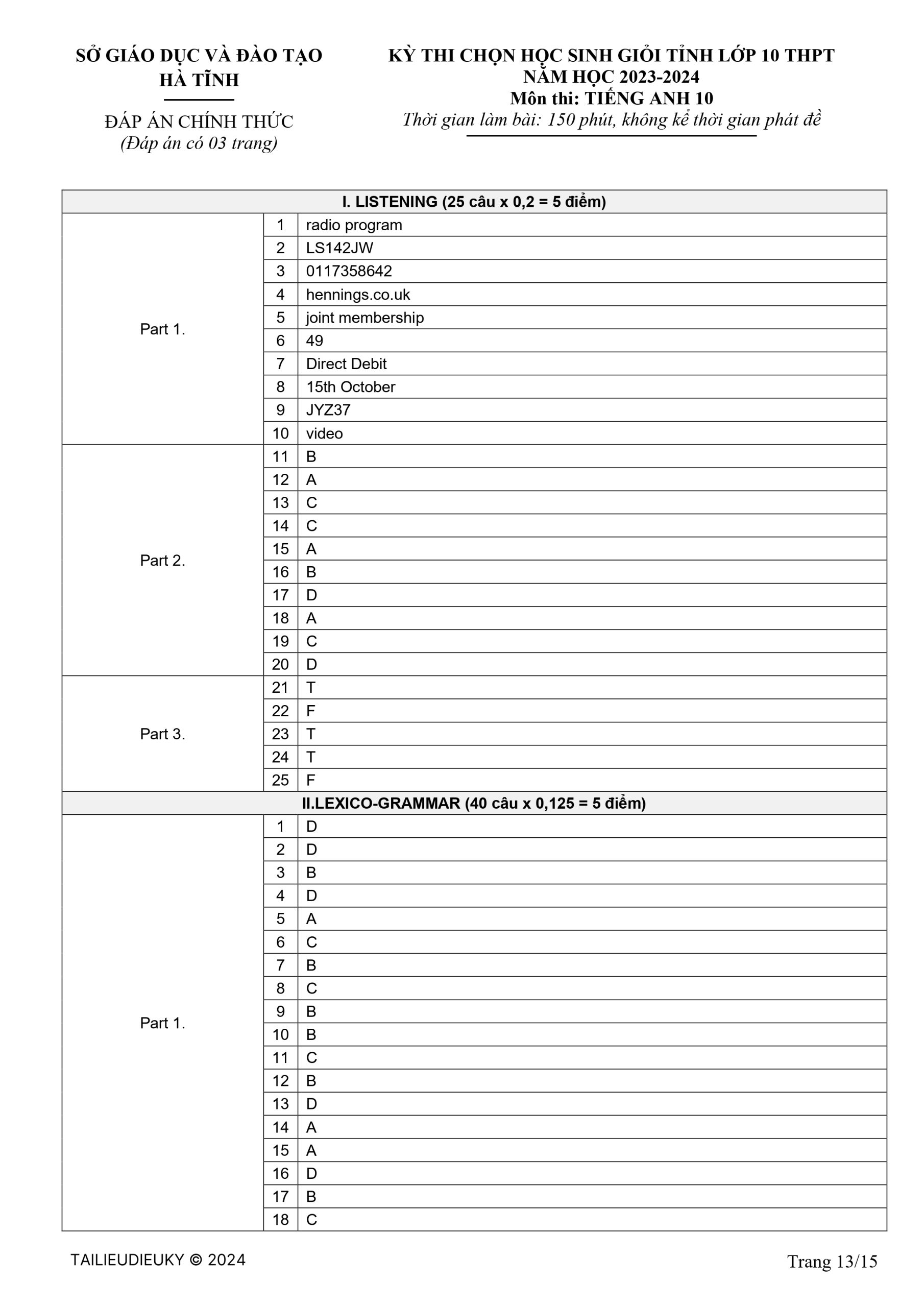
Đáp án chính thức - Tiếng Anh 10, Hà Tĩnh, năm học 2023-2024
Ngoài ra, để đạt được Kết quả tốt nhất trong các Kỳ thi HSG Tiếng Anh 10 cấp tỉnh, bạn có thể tham khảo và tải xuống kho tài liệu, đề thi mới nhất tại tailieudieuky.com với Tuyển tập các đề thi mới nhất từ các tỉnh/TP lớn như Hà Nội, TP Hồ Chí Minh, Hải Phòng, Nghệ An, Hà Tĩnh, Thanh Hóa, Đà Nẵng, Cần Thơ... với đầy đủ đề thi và đáp án chi tiết để làm quen các dạng bài và cấu trúc đề thi chính thức. Qua đó, các thí sinh có thể tự tin chinh phục các Kỳ thi HSG cấp THPT.
Đáp án chính thức Đề thi HSG lớp 10 cấp tỉnh tại Hà Tĩnh năm 2023:
SỞ GIÁO DỤC VÀ ĐÀO TẠO
HÀ TĨNH
ĐÁP ÁN CHÍNH THỨC
(Đáp án có 03 trang)
KỲ THI CHỌN HỌC SINH GIỎI TỈNH LỚP 10 THPT
NĂM HỌC 2023-2024
Môn thi: TIẾNG ANH 10
Thời gian làm bài: 150 phút, không kể thời gian phát đề
I. LISTENING (25 câu x 0,2 = 5 điểm)
Part 1. 1 radio program
2 LS142JW
3 0117358642
4 hennings.co.uk
5 joint membership
6 49
7 Direct Debit
8 15th October
9 JYZ37
10 video
Part 2. 11 B
12 A
13 C
14 C
15 A
16 B
17 D
18 A
19 C
20 D
Part 3. 21 T
22 F
23 T
24 T
25 F
II.LEXICO-GRAMMAR (40 câu x 0,125 = 5 điểm)
Part 1. 1 D
2 D
3 B
4 D
5 A
6 C
7 B
8 C
9 B
10 B
11 C
12 B
13 D
14 A
15 A
16 D
17 B
18 C
19 A
20 B
Part 2. 21 attractions
22 uncertainty
23 impassable
24 ongoing
25 deprived
26 repeatedly
27 independence
28 breakage(s)
29 degenerative
30 impoverished
Part 3. 31 head for heights
32 mind over matter
33 guest of honor
34 safety in numbers
35 force of habit
36 cup of tea
37 stock in trade
38 vote of thanks
39 peace of mind
40 source of tension
III. READING (40 câu x 0,125 = 5 điểm)
Part 1. 1 A
2 D
3 C
4 D
5 B
6 C
7 A
8 D
9 A
10 B
Part 2. 11 enter/start
12 settling
13 only
14 old
15 However
16 replaced
17 against
18 fact
19 which
20 least
Part 3. 21 D
22 B
23 C
24 A
25 YES
26 NOT GIVEN
27 NO
28 curry
29 natural/organic
30 chemical
Part 4. 31 A
32 D
33 C
34 A
35 B
36 C
37 D
38 C
39 B
40 D
IV. WRITING
Part 1.
(1,0 điểm - Mỗi câu đúng: 0,2 điểm) 1 On their arrival at the party, everyone was dancing and singing happily.
2 Only by using a language/it regularly can you really master it/a language.
3 It was not until Anna spoke to the doctor that she understood how serious her illness was.
4 He made great efforts to win a scholarship to the National College of Music.
5 The government has replaced the blame on the worldwide economic slowdown for our problems.
Part 2.
(1,0 điểm - Mỗi câu đúng: 0,2 điểm) 6 Francis opted for computing in preference to marketing for his next course.
7 His colleague will go to any lengths to avoid confrontation
8 She had (got) it on authority that the local newspaper is going to shut down.
9 Coming second was (of) no consolation (to her) because winning was all that mattered to her.
10 Very much to my disappointment, I was passed over for a part in the school play.
Part 3.
(3,0 điểm) Giám khảo tự quyết định dựa vào các yêu cầu sau:
- Task Response (25%): fully addresses all parts of the task, presents a fully developed position in answer to the question with relevant, fully extended and well supported ideas
- Coherence and Cohesion (25 %): links information and ideas logically, uses a range of cohesive devices appropriately, presents a clear central topic within each paragraph.
- Lexical resources (25%): uses a wide range of vocabulary fluently and flexibly, uses some uncommon lexical items, produces rare errors in spelling and/or word formation.
- Grammar/Structures (25%): Uses a wide range of structures accurately and flexibly with few errors or inappropriateness.
Nội dung Đề thi học sinh giỏi môn Tiếng Anh 10 năm học 2023-2024
SỞ GIÁO DỤC VÀ ĐÀO TẠO
HÀ TĨNH
ĐỀ THI CHÍNH THỨC
(Đề thi có 12 trang)
KỲ THI CHỌN HỌC SINH GIỎI TỈNH LỚP 10 THPT
NĂM HỌC 2023-2024
Môn thi: TIẾNG ANH 10
Thời gian làm bài: 150 phút, không kể thời gian phát đề
- Thí sinh không sử dụng bất kể tài liệu nào, kể cả từ điển.
- Thí sinh làm bài trực tiếp vào đề thi, ghi câu trả lời vào các ô trống hoặc các ô cho sẵn.
- Riêng phần trắc nghiệm, thí sinh chỉ ghi đáp án A, B, C hoặc D.
- Cán bộ coi thi không giải thích gì thêm.
Điểm của toàn bài thi Cán bộ chấm thi
Ký và ghi rõ họ tên Mã phách
Do Ban làm phách ghi
Bằng số Bằng chữ Cán bộ chấm thi 1:
Cán bộ chấm thi 2:
I. LISTENING
Part 1. Listen to a conversation and fill in each gap with NO MORE THAN 2 words AND/OR a number. Write your answers in the corresponding numbered boxes.
Wildlife Conservation Society
Membership Application Form
Applicant Information:
Caller’s Name: Michael Jones
Source of WCS Information: (1) __________
Address: 21 Beel Street, Leeds
Postcode: (2) __________
Phone Number: (3) __________
Email Address: (4) mj@__________
Membership Details:
Length of Membership: 2 years
Type of Membership: (5) __________
Membership Fee: (6) £__________
Payment Information:
Payment Method: (7) __________
Bank Name: The Union Bank
Account Name: Michael Jones
Account Number: 01059612
Date of First Payment: (8) __________
Reference Number: (9) __________
Additional Requests:
Extra Information Pack: (10) __________
Part 2. Listen to a talk and choose the best answer A, B, C or D for each of the following questions. Write your answers in the corresponding numbered boxes.
11. According to Graham Hill, how much more space do Americans have now compared to 50 years ago?
A. Twice the amount B. Three times the amount
C. Four times the amount D. Five times the amount
12. What has become a 22-billion-dollar industry, according to Graham Hill’s talk?
A. Personal storage B. Real estate C. Home improvement D. Interior design
13. According to Graham Hill, a good thing for you to save some money is __________.
A. more freedom B. more time C. less stuff D. less footprint
14. What is the focus of Graham Hill’s project “Life Edited”?
A. Personal storage solutions B. Space-efficient furniture
C. Editing possessions for a smaller footprint D. Home renovation ideas
15. How much money does Graham Hill estimate saving by buying a smaller apartment?
A. $200,000 B. $300,000 C. $420,000 D. $600,000
16. According to Graham Hill, what is the first approach to living with less?
A. Increase the inflow of possessions B. Edit possessions ruthlessly
C. Buy impulsively D. Expand the space
17. What does Graham Hill suggest is the new mantra for living with less?
A. Large is luxurious B. Size doesn’t matter C. More is better D. Small is sexy
18. Graham Hill gave the example of six burner stove to suggest using __________.
A. space efficiently B. stove less
C. paperwork effectively D. digital things more
19. According to Graham Hill, what are the benefits of multifunctional spaces and housewares?
A. Increased clutter B. Reduced efficiency C. Greater flexibility D. Larger footprint
20. What does Graham Hill suggest people consider when they walk through their front door, according to the talk’s conclusion?
A. Renovating their homes for a second time
B. Adding more possessions such as a couple of bags
C. Embracing a life of excess that gives you a little more freedom
D. Considering a little life editing for more freedom and time
Part 3. Listen to an interview and decide whether the following statements are TRUE or FALSE. Write your answers in the corresponding numbered boxes.
21. In 2014, Taylor Swift achieved a Number One Hit with “Shake It Off”.
22. She always played the piano in the middle of the night.
23. In merely 13 years of her career, she has evolved into a formidable musical influence.
24. According to Taylor Swift, different standards of language apply to men and women in the music industry.
25. She writes all of her songs on her own and her music videos are all her version.
II. LEXICO-GRAMMAR
Part 1. Choose the word or phrase that best completes each sentence. Write your answer A, B, C or D in the corresponding numbered boxes.
1. The customs officer requested that she __________ her suitcase.
A. to open B. opening C. opens D. open
2. - Ken: “Didn’t you go to the conference?” - Rosie: “__________”
A. No, I went there with my friends. B. That sounds nice, but I can’t.
C. Don’t worry. I’ll go there. D. I did, but I didn’t stay long.
3. The job requires excellent communication skills and an ability to think on your __________.
A. teeth B. feet C. hands D. lips
4. __________ to interfere in your affairs but I would like to give you just one piece of advice.
A. It is far from clear B. Far and wide for me C. Far from it to me D. Far be it from me
5. Visitors to the local museum are mostly attracted by __________ corridor.
A. a fantastic modern Asian leather B. a modern fantastic leather Asian
C. a leather modern fantastic Asian D. a modern leather Asian modern
6. At that time, there were over sixty steamboats on the Mississippi river, __________ were quite luxurious.
A. which many B. many of them C. many of which D. that many
7. The 10% rise in the cost of living is almost unbelievable until it one looks at it in the __________ of world price rises.
A. relationship B. context C. significance D. situation
8. Only when a great deal of more information has been obtained __________ to plan a manned trip to the planet.
A. will be likely B. it will probably be C. will it be possible D. it will possibly be
9. The tenant must be prepared to decorate the property __________ the terms of the agreement.
A. in relation to B. in accordance with C. with regard to D. by any manner of
10. Becoming a famous TikToker means that you should be physically and mentally ready to __________ all viewers’ remarks.
A. consume B. swallow C. eat D. digest
11. He tried to __________ himself with everyone by paying them compliments.
A. gratify B. please C. ingratiate D. commend
12. I parked in a restricted area and the police __________ my car.
A. imprisoned B. impounded C. impaled D. impeached
13. A huge crowd __________ in the pouring rain to cheer the president.
A. dropped in B. held up C. saw off D. turned out
14. Being __________ out of $20,000 by his best friend, he swears not to put trust in anyone else.
A. done B. made C. cheated D. tricked
15. I supposed he could __________ have reached the summit on his own, but I doubt it.
A. conceivably B. creditably C. imaginatively D. believably
16. His happy-go-lucky attitude means that on the field he exhibits a __________ disregard for the rules.
A. required B. glaring C. permissible D. flagrant
17. Normally, when he was late, he gave a pathetic excuse, but not this time, what he said had a __________ of truth about it.
A. ring B. glimmer C. figment D. shred
18. The Government is trying to __________ when it says it will spend more on the health service without raising taxes.
A. chew the fat B. wave the flag C. square the circle D. put the lid
19. __________ in several early civilizations, a cubit was based on the length of the forearm from the tip of the middle finger to the elbow.
A. Used as a measurement B. A measurement was used
C. The use of a measurement D. It was used as a measurement
20. After the earthquake, the entrance hall was turned into a __________ casualty ward.
A. mainstay B. makeshift C. piecework D. wayside
Part 2. Write the correct FORM of each bracketed word in each sentence in the corresponding numbered boxes.
21. Among many (ATTRACT) __________ on the island, Mc. Holland allows you to enjoy water sports such as water-skiing and windsurfing and explore fascinating coral reefs.
22. After a period of criticism and (CERTAIN) __________, the use of criminal statistics has been regaining broad acceptance.
23. Due to a huge pile-up, the motorway will remain (PASS) __________until next week.
24. No agreement has yet been reached and the negotiations are still (GO) __________.
25. When I first came to London, I lived in a(n) (DEPRIVE) __________ area, not far from the exit of a dual carriageway.
26. Over the centuries, mathematicians have identified many different types of spirals and helices, but the most intriguing are those that (REPEAT) __________ occur in the natural world.
27. After decades of struggle, Vietnam gained its (DEPEND) __________ from France in 1945.
28. To avoid (BREAK) __________ on the journey, we’d better pack the glasses in either cotton wool of soft paper.
29. A(n) (GENERATE) __________ disease is one that will gradually deteriorate the functioning of any one part in your body.
30. Both of the first sides have agreed on a temporary (POOR) __________ just to let the civilians safely leave the place.
Part 3. Match the item on the left to an item on the right to form collocations. Then use each of the collocations to fill in the sentences below. Write your answers in the corresponding numbered boxes.
head for cup of mind over matter habit thanks
vote of guest of stock in tea trade heights
force of source of tension mind
safety in peace of numbers honor
31. Susan doesn’t like driving through the mountains, as she has no __________.
32. I you want to get well, you should think positively. Better health can be a question of __________.
33. The Prime Minister, the __________, was warmly welcomed by all locals.
34. I’ll go to the dance on Friday if you will! After all, there’s __________.
35. Oh, dear. I’ve written my old address on all these documents from __________.
36. Thanks for inviting me, but ballet isn’t really my __________.
37. A persuasive manner is the __________ of a lawyer.
38. The chairperson proposed a __________ to the head of fundraising.
39. Please call your mother the moment you’ve arrived to let her know you’re safe. That will give her some __________.
40. Money is often a __________ in many young married couples.
III. READING
Part 1. Read the following passage and decide which answer (A, B, C, or D) best fits each gap. Write your answer in the corresponding numbered boxes.
From a very early age, it was apparent that Magnus Carlen was a brilliant chess player. By the age of 13, Magnus was (1) __________ to be one of the best chess players in the world, and his parents wanted him to reach his (2) __________ potential as a professional chess player. This meant their son had to develop a lifestyle of strict (3) __________ which included many hours of practice. Only this way could he become a world champion. (4) __________ Magnus’ parents supported him, they did not want him to devote his whole life to chess. They felt that if he focused only on chess, he would suffer both physically (5) __________ emotionally. They made it clear to him that they had no intention of letting their son drop out of school. He was also encouraged to follow his interest in sports. As a result of his (6) __________, when Magnus graduate from high school in 2009, he was not only the best chess player in the world, but he was also awarded the title of “sport-student of the year” for his achievements in snowboarding and golf. Today, Magnus gives (7) __________ to his parents for the way they (8) __________ him. They set rules, but they never (9) __________ with his ambitions. Instead they gave him the (10) __________ and encouragement he needed to achieve his goals and still be a happy young man.
1. A. considered B. recognized C. decided D. counted
2. A. complete B. whole C. entire D. full
3. A. order B. behavior C. discipline D. effort
4. A. Since B. Until C. Because D. Although
5. A. or B. and C. either D. but
6. A. treatment B. environment C. upbringing D. preparation
7. A. credit B. attention C. trust D. approval
8. A. taught B. brought C. grew D. raised
9. A. interfered B. opposed C. mistrusted D. prevented
10. A. approach B. support C. contact D. recommendation
Part 2. Fill each of the following numbered blanks with ONE suitable word and write your answers in the corresponding numbered boxes.
THE CHANGING FACE OF WORKING LIFE
The accepted concept of a career path followed a similar pattern for decades. After completing their education, people would (11) __________ the adult world of work, (12) __________ down on to a job which they would likely remain from that point onwards. Not (13) __________ would this occupation provide their income for their entire working life, it would also allow them a healthy pension when they retired and moved into (14) __________ age. Over the past twenty years, (15) __________, the relationship between a wage earner and their chosen profession has changed enormously. Today, the idea of a ‘job-for-life’ has all but disappeared, to be (16) __________ by an unforgiving world of unstable employment. Some observers even argue that current society to pit old (17) __________ young in a constant battle to find work of some description, all against a backdrop of increasing debt and economic difficulties.
At the same time, the government regularly releases figures that suggest the economy is prospering, evidencing this claim with the (18) __________ that the unemployment rate continues to fall annually. There are indeed more jobs available. However, a huge number of these are casual, temporary or short-term positions, all of (19) __________ are low-paid and create little in the way of tax income for the government. This has a number of debilitating long- term effects, not (20) __________ because this assurance of a growing economy is based more in myth than fact.
Part 3. Read the following passage and do the tasks that follow. Write your answers in the corresponding numbered boxes.
ORGANIC FARMING AND CHEMICAL FERTILISERS
A. The world’s population continues to climb. And despite the rise of high-tech agriculture, 800 million people don’t get enough to eat. Clearly, it’s time to rethink the food we eat and where it comes from. Feeding 9 billion people will take more than the same old farming practices, especially if we want to do it without felling rainforests and planting every last scrap of prairie. Finding food for all those people will tax farmers’ – and researchers’ – ingenuity to the limit. Yet already, precious aquifers that provide irrigation water for some of the world’s most productive farmlands are drying up or filling with seawater, and arable land in China is eroding to create vast dust storms that redden sunsets as far away as North America. “Agriculture must become the solution to environmental problems in 50 years. If we don’t have systems that make the environment better – not just hold the fort-then we’re in trouble,” says Kenneth Cassman, an agronomist at the University of Nebraska at Lincoln. That view was echoed in January by the Curry report, a government panel that surveyed the future of farming and food in Britain.
B. It’s easy to say agriculture has to do better, but what should this friendly farming of the future look like? Concerned consumers come up short at this point, facing what appears to be an ever-widening ideological divide. In one corner are the techno-optimists who put their faith in genetically modified crops, improved agrochemicals and computer-enhanced machinery; in the other are advocates of organic farming, who reject artificial chemicals and embrace back-to-nature techniques such as composting. Both sides cite plausible science to back their claims to the moral high ground, and both bring enough passion to the debate for many people to come away thinking we’re faced with a stark choice between two mutually incompatible options.
C. Not so. If you take off the ideological blinkers and simply ask how the world can produce the food it needs with the least environmental cost, a new middle way opens. The key is sustainability: whatever we do must not destroy the capital of soil and water we need to keep on producing. Like today’s organic farming, the intelligent farming of the future should pay much more attention to the health of its soil and the ecosystem it’s part of. But intelligent farming should also make shrewd and locally appropriate use of chemical fertilisers and pesticides. The most crucial ingredient in this new style of agriculture is not chemicals but information about what’s happening in each field and how to respond. Yet ironically, this key element may be the most neglected today.
D. Clearly, organic farming has all the warm, fuzzy sentiment on its side. An approach that eschews synthetic chemicals surely runs no risk of poisoning land and water. And its emphasis on building up natural ecosystems seems to be good for everyone. Perhaps these easy assumptions explain why sales of organic food across Europe are increasing by at least 50 per cent per year.
E. Going organic sounds idyllic – but it’s native, too. Organic agriculture has its own suite of environmental costs, which can be worse than those of conventional farming, especially if it were to become the world norm. But more fundamentally, the organic versus-chemical debate focuses on the wrong question. The issue isn’t what you put into a farm, but what you get out of it, both in terms of crop yields and pollutants, and what condition the farm is in when you’re done.
F. Take chemical fertilisers, which deliver nitrogen, an essential plant nutrient, to crops along with some phosphorus and potassium. It is a mantra of organic farming that these fertilisers are unwholesome, and plant nutrients must come from natural sources. But in fact, the main environmental damage done by chemical fertilisers as opposed to any other kind is through greenhouse gases-carbon dioxide from the fossil fuels used in their synthesis and nitrogen oxides released by their degradation. Excess nitrogen from chemical fertilisers can pollute groundwater, but so can excess nitrogen from organic manures.
G. On the other hand, relying solely on chemical fertilisers to provide soil nutrients without doing other things to build healthy soil is damaging. Organic farmers don’t use chemical fertilisers, so they are very good at building soil fertility by working crop residues and manure into the soil, rotating grain with legumes that fix atmospheric nitrogen, and other techniques.
H. This generates vital soil nutrients and also creates a soil that is richer in organic matter, so it retains better and is hospitable to the crop’s roots and creatures such as earthworms that help maintain soil fertility. Such soil also holds water better and therefore make more efficient use of both rainfall and irrigation water. And organic matter ties up CO2 in the soil, helping to offset emissions from burning fossil fuels and reduce global warming.
I. Advocates of organic farming like to point out that fields managed in this way can produce yields just as high as fields juiced up with synthetic fertilisers. For example, Bill Liebhardt, research manager at the Rodale Institute in Kutztown, Pennsylvania, recently compiled the results of such comparisons for corn, wheat, soybeans and tomatoes in the US and found that the organic fields averaged between 94 and 100 per
J. But this optimistic picture tells only half the story. Farmers can’t grow such crops every year if they want to maintain or build soil nutrients without synthetic fertilisers. They need to alternate with soil-building crops such as pasture grasses and legumes such as alfalfa. So in the long term, the yield of staple grains such as wheat, rice and corn must go down. This is the biggest cost of organic farming. Vaclav Smil of the University of Manitoba in Winnipeg, Canada, estimates that if farmers worldwide gave up the 80 million tonnes of synthetic fertiliser they now use each year, total grain production would fall by at least half. Either farmers would have to double the amount of land they cultivate – at catastrophic cost to natural habitats – or billions of people would starve.
K. That doesn’t mean farmers couldn’t get by with less fertiliser. Technologically advanced farmers in wealthy countries, for instance, can now monitor their yields hectare by hectare, or even more finely, throughout a huge field. They can then target their fertiliser to the parts of the field where it will do the most good, instead of responding to average conditions. This increases yield and decreases fertiliser use. Eventually, farmers may incorporate long-term weather forecasts into their planning as well, so that they can cut back on fertiliser use when the weather is likely to make harvests poor anyway, says Ron Olson, an agronomist with Cargill Fertilizer in Tampa, Florida.
L. Organic techniques certainly have their benefits, especially for poor farmers. But strict “organic agriculture”, which prohibits certain technologies and allows others, isn’t always better for the environment. Take herbicides, for example. These can leach into waterways and poison both wildlife and people. Just last month, researchers led by Tyrone Hayes at the University of California at Berkeley found that even low concentrations of atrazine, the most commonly used weedkiller in the US, can prevent frog tadpoles from developing properly.
Question 21-24: Use the information in the passage to match the people (listed A-D) with opinions or deeds below. Write the appropriate letters A-D in boxes 21-24 provided.
A. Vaclay Smil
B. Bill Liebhardt
C. Kenneth Cassman
D. Ron Oison 21. Use of chemical fertilizer can be optimized by combining weather information. __________
22. Organic framing yield is nearly equal to traditional ones. __________
23. Better agricultural setting is a significant key to solve environmental tough nut. __________
24. Substantial production loss would happen in case all farmers shifted from using synthetic fertiliser. __________
Question 25-27: Do the following statements agree with the information given in the reading passage? Write your answers in boxes 25-27 provided.
YES - If the statement agrees with the information
NO - If the statement contradicts the information
NOT GIVEN - If there is no information on this
25. Increasing population, draining irrigation, eroding farmland push agricultural industry to extremity. __________
26. Chemical fertilisers currently are more expensive than the natural fertilisers. __________
27. “Organic agriculture” is the way that environment-damaging technologies are all strictly forbidden. __________
Question 28-30: Complete the following summary of the paragraphs of the reading passage, using NO MORE THAN two words from the reading passage for each answer. Write your answers in boxes 28-30 provided.
Several farming approaches need to be applied in order that the global population wouldn’t go starved. A team called (28) __________ repeated the viewpoint of a scholar by a survey in British farming. More and more European farmers believe in (29) __________ farming these years. The argument of organic against (30) __________ seems in an inaccurate direction.
Part 4: Read the following passage and choose the answer A, B, C or D that fits best according to the fext. Write your answers in the corresponding numbered boxes provided.
In the rapidly evolving digital age, technology has emerged as a double-edged sword that has the power to both connect and isolate people. The question of whether technology has brought people closer or led to isolation is a complex and multifaceted one. Over the past few decades, technological advancements have transformed the way we communicate, socialize, and interact with the world around us. While these innovations have undoubtedly connected us in ways never before possible, they have also raised concerns about the erosion of meaningful human connections and the potential for isolation.
[A] To explore this topic comprehensively, we must consider the various dimensions of technology’s impact on human relationships and social dynamics. From the advent of the internet and social media to the proliferation of smartphone and virtual reality, it has reshaped the way we form connections, maintain relationships, and experience the world. Technology has also fostered closeness and examining instances where it has contributed to isolation. Ultimately, it will become evident that the influence of technology on human connection is a complex interplay of both positive and negative forces.
One of the most striking ways technology has brought people closer together is through global connectivity. [B] Social media platforms like Facebook, Twitter, and Instagram have enabled individuals to connect with friends, family, and even strangers on a global scale. This newfound global connectivity has fostered cross-cultural understanding and collaboration, transcending geographical boundaries. Technology has revolutionized the way we communicate, making it faster, more convenient, and more accessible. Email, instant messaging, and video conferencing platforms have made it possible for people to stay in touch with loved ones, regardless of their physical location. Furthermore, the emergence of smartphones has put communication tools at our fingertips, allowing us to connect with others on the go.
The internet has given rise to a multitude of online communities and forums where people with shared interests can come together. [C] These virtual spaces allow individuals to find like-minded people, share their passions, and build supportive communities. Whether it’s a subreddit for a niche hobby or a Facebook group for a specific cause, these online communities facilitate connections that might not have been possible in the past.
While social media platforms have the potential to connect people, they have also been criticized for fostering shallow and superficial relationships. The “like” and “follow” culture often prioritizes quantity over quality, leading to a sense of isolation as individuals may feel disconnected from their online personas. People may curate their lives for social media, portraying an idealized version of themselves that does not reflect their true experiences or emotions.
[D] The omnipresence of screens in our lives, from smartphones to computers, has led to concerns about screen addiction. Excessive screen time can lead to physical and mental health issues, including anxiety and depression. It can also hinder face-to-face interactions, as individuals may choose to engage with screens rather than the people around them. The advent of virtual reality (VR) technology has raised questions about the potential for people to become isolated in virtual worlds. While VR can be a powerful tool for gaming and entertainment, spending too much time in virtual environments can disconnect individuals from their physical surroundings and relationships. Escapism into virtual realities can lead to isolation in the real world.
The anonymity afforded by technology can lead to cyberbullying and toxic online behavior. People may feel emboldened to engage in hurtful or harmful actions when shielded by the digital veil of anonymity. This type of behavior can create a hostile online environment that discourages meaningful interaction. To assess whether technology has brought people closer or led to isolation, it is essential to recognize that the impact of technology is not uniform. It varies from person to person and depends on how individuals choose to use and engage with technology.
Ultimately, the responsibility for how technology affects our lives lies with each individual. It is up to us to use technology mindfully and in ways that enhance our connections rather than isolate us. Setting boundaries for screen time, curating our online interactions, and prioritizing face-to-face communication when possible can all mitigate the potential for isolation. Technology has the potential to both connect and isolate simultaneously. For example, a person might use their smartphone to video call a friend on the other side of the world while ignoring the people physically present in the room. This highlights the importance of striking a balance between our digital and real-world interactions. Education and digital literacy play a crucial role in ensuring that people use technology in ways that foster connection. Teaching individuals how to navigate the digital landscape responsibly, recognize the signs of screen addiction, and engage with online communities thoughtfully can help mitigate the negative aspects of technology.
The impact of technology on human connection is an ongoing story. As technology continues to evolve, so too will its effects on society. It is essential for individuals, policymakers, and technology developers to remain vigilant and adapt to the changing landscape.
31. What should be the best title for the above passage?
A. “The Effects of Technology on Human Connection”
B. “The Rise of Technology in Modern Society”
C. “The Evolution of Communication in the Digital Age”
D. “The Complex Relationship Between Technology and 1solation”
32. The word it in paragraph 2 refers to __________.
A. Internet B. social media C. smartphone D. technology
33. In which space (marked [A], [B], [C] and [D] in the passage) will the following sentence fit?
The internet, in particular, has made it possible for individuals from different corners of the world to communicate and share ideas instantaneously.
A. [A] B. [B] C. [C] D. [D]
34. According to the passage, which of the following is NOT mentioned as the advantages that the virtual space brings people?
A. finding physical location B. finding like-minded people
C. sharing their passions D. building supportive communities
35. The word “curate” in the passage is closest in meaning to __________.
A. ignore B. cultivate C. manipulate D. marginalize
36. According to the passage, escapism into virtual realities could result in __________.
A. screen addiction B. cyberbullies C. isolation D. mental health issues
37. According to the passage, which of the following is TRUE?
A. The internet and social media platforms have only shallow and superficial connections.
B. Screen addiction is a concern primarily for older generations.
C. Online communities have no impact on building supportive relationships.
D. Technology has the potential to both connect and isolate people.
38. According to the passage, the influence of technology on individuals is __________.
A. negative B. positive C. not the same D. very similar
39. The word “vigilant” in the passage is closest in meaning to __________.
A. complacent B. careful C. apathetic D. inattentive
40. Based on the passage’s discussion of technology’s impact on human connection and isolation, what can be inferred about the author’s perspective?
A. The author believes technology has overwhelmingly positive effects on human connection in all aspects.
B. The author argues that technology primarily leads to isolation and should be limited.
C. The author takes a neutral stance and does not express a clear opinion on the matter.
D. The author acknowledges both positive and negative aspects of technology’s impact on human connection.
IV. WRITING
Part 1: Finish each of the following sentences in such a way that it means exactly the same as the sentence before it. (0) has been done as an example.
0. Keith certainly can’t be held responsible for the accident.
=> In no way can Keith be held responsible for the accident.
1. When they got to the party, everyone was dancing and singing happily.
=> On ________________________________________________________________________________.
2. You can only really master a language if you use it regularly.
=> Only by ____________________________________________________________________________.
3. Anna failed to understand how serious her illness was until she spoke to the doctor.
=> It was not until _______________________________________________________________________.
4. He tried very hard to win a scholarship to the National College of Music.
=> He made ___________________________________________________________________________.
5. The government recently said our problems are the fault of the worldwide economic slowdown.
=> The government has replaced ___________________________________________________________.
Part 2. Use the word given in brackets and make any necessary additions to write a new sentence in such a way that it is as similar as possible in meaning to the original sentence. Do NOT change the form of the given word. You must use between THREE and SIX words, including the word given. (0) has been done as an example.
0. Jane regretted speaking so rudely to the old lady (MORE)
=> Jane wishes she had spoken more politely to the old lady.
6. Barbara chose computing rather than marketing for her next course. (PREFERENCE)
=> Francis opted _________________________________________________________ for his next course.
7. His colleague will do anything to avoid confrontation. (LENGTHS)
=> His colleague ______________________________________________________ to avoid confrontation.
8. A reliable source told her that the local newspaper is going to shut down. (AUTHORITY)
=> She ___________________________________________ that the local newspaper is going to shut down.
9. Coming second didn’t make her feel any better because she only wanted to win. (CONSOLATION)
=> Coming second ___________________________________ because winning was all that mattered to her.
10. I was bitterly disappointed they didn’t give me a part in the school play. (PASSED)
=> Very much to __________________________________________________ for a part in the school play.
Part 3. Write an essay of about 250 words on the following topic:
It is claimed that school workout benefits both physical and mental health for students.
To what extent do you agree or disagree with this idea? Use specific information and examples to illustrate your opinions.
---------- HẾT ----------
